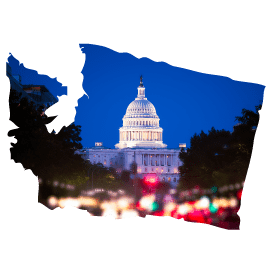Pension Sustainability: Washington
Retaining Effective Teachers Policy
Analysis of Washington's policies
As of June 30, 2009, the most recent date for which an actuarial valuation is available, Washington's teacher pension system is 116 percent funded and has no amortization period for Plans 2 and 3. This means that the state does not currently have any unfunded liabilities to pay off. Washington's system is financially sustainable according to actuarial benchmarks. However, it should be noted that Plan 1, which was closed to new members in October 1977, is only 84 percent funded and has an amortization period of 10 years.
However, Washington commits excessive resources toward its teachers' retirement system. The current employer contribution rate of 9.18 percent is slightly too high, in light of the fact that local districts must also contribute 6.2 percent to Social Security. The rate of 5.57 percent of this contribution goes to funding Plans 2 and 3, while the additional 3.61 is used to pay off unfunded liabilities in Plan 1. While this rate allows the state to overfund its current plan and pay off unfunded liabilities of its previous plan, it does so at great cost, precluding Washington from spending those funds on other, more immediate means to retain talented teachers. The mandatory employee contribution rates for Plan 2 of 4.8 percent and for Plan 3 of 5 percent are reasonable.
Recommendations for Washington
Avoid committing excessive resources to the pension system.
Washington is commended for having a current system that is over 100 percent funded. However, its closed system is underfunded and remains a financial burden on the current employees and employers. The state should consider decreasing employer contributions to allow the state and local districts to spend those funds on more immediate recruitment and retention strategies.
State response to our analysis
Washington recognized the factual accuracy of this analysis.
Select another topic
Delivering Well Prepared Teachers
- Admission into Preparation Programs
- Elementary Teacher Preparation
- Elementary Teacher Preparation in Reading Instruction
- Elementary Teacher Preparation in Mathematics
- Middle School Teacher Preparation
- Secondary Teacher Preparation
- Secondary Teacher Preparation in Science
- Secondary Teacher Preparation in Social Studies
- Special Education Teacher Preparation
- Assessing Professional Knowledge
- Student Teaching
- Teacher Preparation Program Accountability
Expanding the Pool of Teachers
Identifying Effective Teachers
- State Data Systems
- Evaluation of Effectiveness
- Frequency of Evaluations
- Tenure
- Licensure Advancement
- Equitable Distribution

